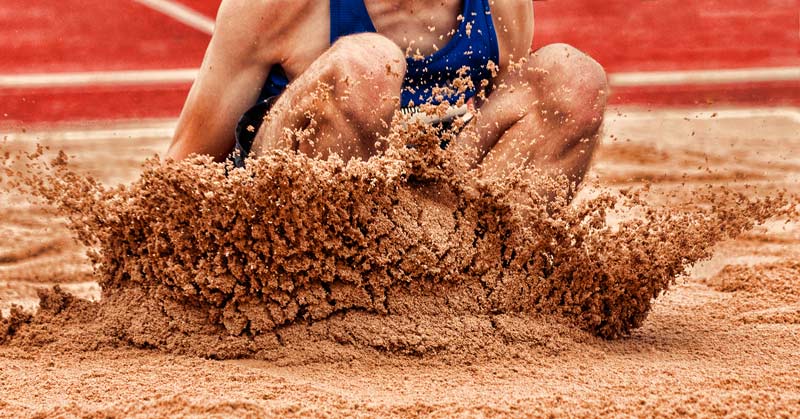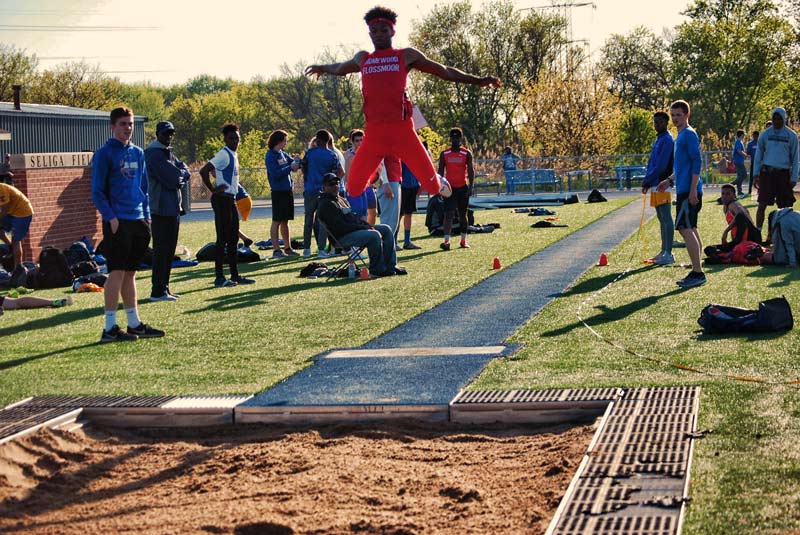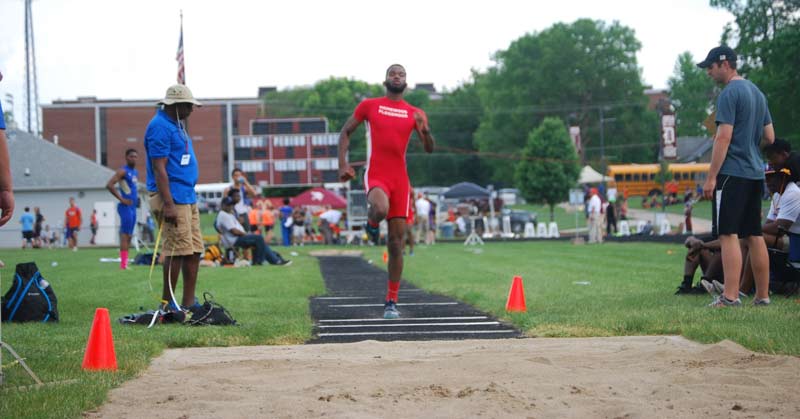
A colleague recently asked me what would be the ideal off-season program for high school jumpers (long/triple/high). Programming for any athlete involved in a power sport should revolve around improving their ability to move faster by applying greater force in less time. Qualities that address this objective are increased speed, strength, elasticity, and coordination. The off-season is also an ideal time to enhance work capacity. This, along with the addition of progressive variation as time goes on, will lead to a more robust athlete when the season starts.
In a perfect scenario, the degree to which each of the qualities is addressed would be individualized with a coach monitoring progress and adjusting programming as needed. At the high school level, however, this is often not an option in the off-season due to conditions set by governing bodies. Therefore, the focus here is to provide options that high school jumpers can complete on their own.

Consideration #1: Fall/Winter Sports
I would be a hypocrite if I did not note that track and field jumpers should participate in other school sports. Football, soccer, volleyball, and basketball all translate very well to the off-season work needed for jumpers. I would even say that cross country could be an option if the coach runs a progressive program and is willing to train the athlete like a sprinter.
The greater a jumper’s athleticism, the more adaptable the jumper, says @HFJumps. Share on XMany coaches would scoff at this idea, but the way some field/court coaches run their sports is not all that different from cross-country training. Any fall or winter program that prioritizes (or makes exceptions for) developing explosive athletes is a welcoming home for a track and field jumper. Here are some other advantages for a jumper involved in multiple sports:
- It is healthy for athletes with a young training age to get exposure to a wide variety of activities. Studies indicate higher injury rates for athletes who participate in one sport.
- The coordinative pool of a young athlete should be broad and shallow, not narrow and deep. This gives them greater resources to draw from when faced with a task. The greater a jumper’s athleticism, the more adaptable the jumper. If you do not think adaptability is an important skill for a jumper, ponder this: We expect the jumper to take off from the same spot every attempt, but no approach is EVER the same from start to finish.
- It is beneficial for athletes to be coached by other people. Different coaches have different sets of rules and expectations. It is valuable for an athlete to learn how to thrive in various environments.

Consideration #2: Sprint!
I have two general tenets I follow in-season:
- Faster and fresh athletes jump further.
- Fresh and faster athletes jump higher.
I could write another article about these two points, but the emphasis here is that speed must be a year-round priority for horizontal and vertical jumpers. I advise sprinting two times per week on nonconsecutive days. Get creative with your starting position (kneeling, prone/supine, 2/3/4 point, facing different directions, etc.), and spike up if possible.
A simple system would be to start with sprints of 10 meters and increase 5 meters per week, capping out at 40 meters. Keep the total volume between 100 and 120 meters. Give full rest between reps (~1 minute for every 10-meter run) so each rep signifies your maximum capability.


Consideration #3: Play Games!
I think the only reason I ended up with a smidge of athletic ability is because I played pickup games of any sport imaginable as often as possible. Some options are basketball, flag/touch football, ultimate Frisbee, handball, and trashball. Each of these activities incorporates multi-directional movement, change of direction, and “organic” plyometrics, which enhance robustness.
Off-season track athletes not in a fall or winter sports should play games as much as possible, says @HFJumps. Share on XIn my opinion, the king of games to play during this time for a jumper is basketball. The amount of variability in the jumps performed during a game of basketball is second to none. Don’t be afraid to open or close a session with a dunk contest (find an adjustable rim if needed). Incorporate single and double leg takeoffs and try to master as many different dunks as possible (Joel Smith of Just Fly Sports gives some good reasons to do this in this article on slam dunk training. I encourage off-season track athletes not involved in a fall or winter sports to play games as much as possible.

Consideration #4: Barefoot Training/Running
Training barefoot seems to be prevalent in distance running circles, but it should also be part of the training of speed and power athletes. The ankles and feet deliver force to the ground, so an athlete can only transmit force that the ankles and feet can handle. Smith states:
“Whenever the environment and injury risk allows, barefoot work is best. Not only does barefoot work improve intrinsic foot strength automatically, but also allows for a better sensory link of the feet to the ground, a better tripod, and better upstream firing patterns.”1
From a top-down view, an athlete with better feet is more likely to deliver what he or she can generate. From a ground-up view, an athlete can generate more because muscles will be firing in the proper sequence. Win-win!
An excellent off-season option for jumpers is barefoot tempo running (60-80% of maximum effort). Besides getting the aforementioned benefits of barefoot training, tempo running increases the jumper’s work capacity and tendon strength due to the high amount of contacts. According to Smith,
“Single leg jumping is of the ‘explosive isometric’ variety, meaning it relies heavily on a locking action of the muscle combined with strong tendons. Creating strength in the connective tissues needed for jumping demands specificity and adequate repetition.”2

The lengths of the runs can be anywhere from 50 to 300 meters. Recovery should not be complete. In terms of volume, leave something in the tank so you can operate at a high level the following day. Grass is better for barefoot work than field turf because of variability. With a less-consistent surface, your feet get to make minor adjustments during each step.
Straight runs can make up the majority, but also incorporate curvilinear and circle/figure eight running (with a radius of 2 to 10 yards). Soccer fields have a nice center circle to use. The ground contact and force vectors are different in these activities, which gives the ankle-foot complex a different (and essential) challenge to manage. The carry-over to the high jump approach and running curves on the track are obvious, but a benefit for long and triple jumpers is the ability to better absorb force when awkward landings occur.
Video 1. Athletes can modify the amplitude of the waves from rep to rep. As the comfort increases, they can increase the speed at which they do the drill.
Video 2. The athlete demonstrates a circle run with a radius of 4 meters. Athletes should feel outward pressure on their feet. Again, as comfort increases, speed can increase.
For simplicity’s sake, I’m saying that tempo running falls into the same training category as playing games. If you have a choice to complete a tempo running session or play a game, choose the latter! You can always incorporate barefoot movements/running in your warm-up and other parts of training.
If you have never trained barefoot before, ease into it. Training with blisters is far from ideal. Furthermore, you will probably feel the effects of training structures in your lower legs that you did not even know you had.

Consideration #5: Jump Rope
Jumping rope is an overlooked activity that is ideal for jumpers because of the high number of low-intensity contacts that you can achieve with a rhythmic element. Every jump approach and second spent in flight has a rhythm to it, and anything you can do to develop a general sense of rhythm is a plus.
There are several variations that you can do while jumping rope:
- Alternating tempo
- Double, single, and alternating leg combinations
- Jumping on different surfaces (or even with each foot on a different surface)
- Rotating slightly while jumping (about 36-45 jumps per one revolution works well)
- Moving slightly forward, backward, or laterally while jumping
- Running while skipping rope (Besides increasing coordination and rhythm, it cleans up inefficient backside mechanics by making the push-off short and reactive.)3
- Jumping while working up a slight incline or down a slight decline (driveways work well)
If you want to challenge your proprioceptive system, close your eyes while jumping. As mentioned above, if you want more bang for your buck, ditch your shoes and go barefoot. You can jump rope just about every day in reasonable doses, and it is an easy item to incorporate into your warm-up.

Consideration #6: The Weight Room
After much deliberation, I decided to include this section. With the premise of the article being activities athletes can do on their own, it is certainly within reason to say that most novice athletes should not create, nor execute, a weight program independent of a knowledgeable adult’s supervision. Every high school has the group of students who show up to open weights after school and do nothing but socialize, or who have a program and/or technique so poor they probably would be better off socializing.
With this said, there are phases of development where a high school athlete can look at a barbell and get stronger. Couple this with the fact that many have a very low training age, and you have a recipe that will guarantee gains no matter what type of weight program they complete. The goal here, however, is to try to make what is done in the weight room slightly more specific to the high school jumper, which leads to the need to briefly discuss the muscle-tendon unit.
Tendons play a huge role in the track and field jumps due to the reactive nature of the events (takeoff times under two-tenths of a second). Tendons are responsible for transmitting the tension that muscles generate. Because of the low ground contact time, muscles do not have time to generate much force.
Owen Walker of Science for Sport says that it is generally accepted that the tendon is the primary site of the storage of elastic energy.4 The primary analogy used here is of the muscle-tendon unit as a rubber band. When stretched, it stores energy, and when let go, it releases energy.
An easy way to show this is to perform two vertical jumps. Perform the first as a standard countermovement jump. For the second, after descending, pause for two seconds and then try to jump. You can probably feel the difference without any verification from a measurement device. The first jump utilizes the “free” elastic energy provided by the descent, whereas the second one does not. If the tendons are the primary storage spot for elastic energy, optimizing tendon function should be a consideration when designing a weight program for a jumper.
Dr. Michael Yessis, author of “The Revolutionary 1×20 RM Strength Training Program,” says the best way to address tendon strength and thickness for the novice athlete is to take part in a high-volume/low-intensity strength program. The reason is that higher volume leads to greater blood flow, which tendon growth depends upon.5
Optimizing tendon function should be a consideration when designing a weight program for a jumper, says @HFJumps. Share on XYessis’ 1×20 RM program is exactly how it sounds: one set of an exercise for 20 repetitions. Because there is only one set per exercise, a workout menu can consist of around 15-20 exercises as opposed to the four to six exercises for three to four sets that is more typical for a low-volume/high-intensity program.
Besides the importance of tendon development for jumpers, there are other reasons that this system could be the best option in the unsupervised off-season situation:
- By working at a low intensity, the athlete can focus on proper technique.5 The high volume of each set makes it more difficult for athletes to use a weight they cannot handle. Once an athlete compromises form to complete a rep, the set is over.
- The high-volume and one-set combination means more repetition of a greater number of exercises.5 Repetition is a great teacher (assuming the lift is done properly).
- Since the program should address the entire body, athletes can do it twice per week on nonconsecutive days. This again increases the amount of repetition of each exercise per week. Many other programs have different menus on different days.
Another point of note is to ease into the 20-rep range over the course of a few workouts (especially if you are not used to this type of set volume). Once you can achieve the 20 reps with perfect form, then you can increase the load slightly. Yessis’ 1×20 RM book is a quick read for those who want more rationale and programming information.
As mentioned before, there are many ways to get the job done in the weight room—this is just an option that fits well within the goal of this article. I encourage athletes to discuss programming with their coach and always prioritize technique over load!

Consideration #7: Develop Healthy Habits
If a track athlete is not involved in a fall or winter sport, his or her daily schedule is probably less demanding than an in-season athlete. Less obligations can lead to the development of healthy or unhealthy habits. It is always easier to eat Cheetos and play video games than exercise. Make it a priority to develop healthy habits so they become part of your daily routine prior to the start of the track season. This will make you more likely to stick with them throughout the season. Besides remaining active (hopefully using some of the suggestions in this article), these are some additional items to consider.
Designing a Program
Designing a program that takes these items into account could be complicated, but it does not have to be. Find the sweet spot with the considerations addressed. If you planned to do something on a particular day, but then do not feel like doing it on that day, do something else!
While I am a big believer that structure leads to productivity, I also feel that a lack of structure in the off-season is healthy. Take advantage of the power of choice the off-season provides. It certainly does not present itself as often in-season. Above all else, do everything in your power to enter your season happy, healthy, hungry, and bouncy!
References
- Smith, Joel. “10 Ways to Build Better Forefoot and Midfoot Power.” Just Fly Sports, August 17, 2017.
- Smith, Joel. “Long Sprinting for Reactive Vertical Power.” October 24, 2013.
- Bosch, Frans and Ronald Clomp. “Running: Biomechanics and Exercise Physiology Applied in Practice.” Amsterdam: Elsevier, 2005. 313.
- Walker, Owen. “Stretch-Shortening Cycle.” Science for Sport.
- Yessis, Michael. “The Revolutionary 1×20 RM Strength Training Program.” California: Sports Training Inc., 2014. 31-40.




